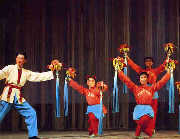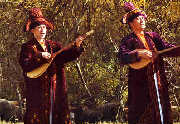Local Ditties
 |
|
Song and Dance duet
|
Local ditties are also called "local tunes", which come from local cultures and have local flavors and styles. There are a variety of local ditties, which spread in their original forms. They fall into two categories: one is shidiao, the other is folk. Shidiao local ditties include Beijingshidiao;Tianjinshidiao; taipinggu of Heilongjiang,Jilinand Liaoning;Shaoxingpinghudiao ofZhejiang;Ningbozoushu; Jiangsu xuanjuan; Anhui flower-drum opera; Shandong liqu; Fujian ditty; errentai of Shaanxi, shanxi and Inner Mongolia; Guangdong yuequ; Nanping tanchang of Sichuan. Folk ditties include Shibuxian lianhualuo of Beijing; Cangzhou mubanshu of Hebei; Qinzhou sanxianshu and Wuxiang sanxianshu of shanxi;Shanghaibozishu; Wuxi xiaorehun ofjiangsu;Suzhouwenshu; Shaoxing lianhualuo of Zhejiang; menge and sijutuizi ofAnhui; Xiangqu shuochang (singing and story-telling) and zhubange of Fujian; Hubei sanbanggu; Lianxiang and chedeng of Sichuan; Ningxia ditties; Ningxia qingqu; Hezhou xianxiao of Gansu; Xining xianxiao of Qinghai.
As the history of their existence varies, the aforementioned local ditties are at different stages of development. Some are mature such as Guangdong yuequ; some are more primitive with simple tunes. Nonetheless, all of them have taken deep root in the local cultures and are popular among the people.
Quyi Music of China's Ethnic Groups
 |
|
Tuole'ao of Hasake Ethnic Group
|
China is a country of multi-ethnic groups. Its 55 ethnic minorities are diverse and colorful due to their different history, physical environments, ethnic cultures, linguistic rhymes, and folklores and customs. The popular ones are dabenqu ofBai Ethnic Group; gesa' erzhong, lama mani and zhege of Tibetan Ethnic Group; wuliger, and haolaibao of Mongolia Ethnic Group;dasitan, kuxiake and laipair ofUyger Ethnic Group; kesa, ayitesi and tie5 ermai of Hasake Ethnic Group; pansuoli of Korean Ethnic Group; molun, changshi and buya ofZhuang Ethnic Group; yimakan of Hezhe Ethnic Group; junpipa ofDong Ethnic Group; gabaim and guoha of Miao Ethnic Group; fenpengrao ofBuyi Ethnic Group; ganhaganpai of Dai Ethnic Group; and Jiasu of Yi Ethnic Group. Among these diverse genres, some have some have existed for a long time and have their own traditions; others come into being under the influences of the opera music of Han people or other Minorities.
Ouyi music of minorities is characterized by strong local flavors and ethnic cultures. Some of them are about stories of the minority and sometimes the lyrics are ethnic epics. They are characterized by recitability, bright calm rhythms and local styles. Some of them come from sacrifice ceremonies and are connected closely to local with strong rhythms and melodiousness. They are performed in the form of singing and dancing or playing instruments while singing. Some of them come from folktales, myths or folklores and the tunes mainly come from folk songs. They are characterized by beauty and passion. Some lyrics come from inprovisational eulogies or praises and are characterized by smoothness, liveliness and humor, and are very popular among their own ethnic groups.
